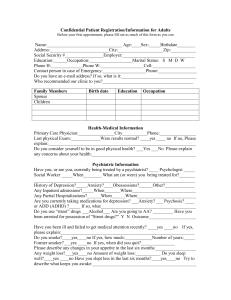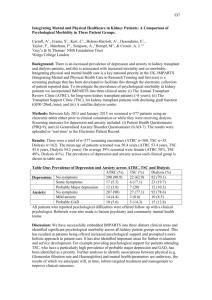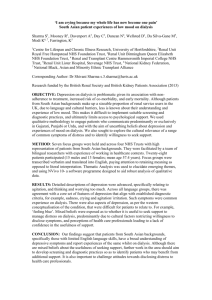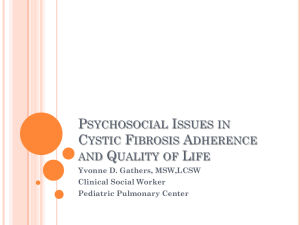333-982-1-RV - ASEAN Journal of Psychiatry
advertisement
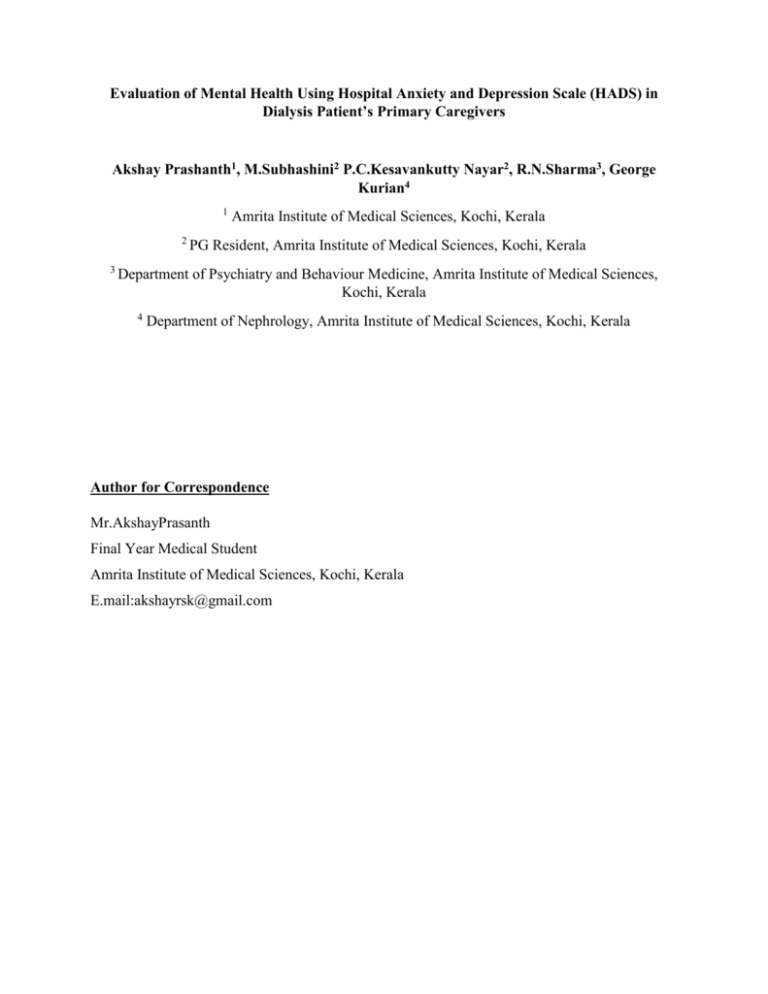
Evaluation of Mental Health Using Hospital Anxiety and Depression Scale (HADS) in Dialysis Patient’s Primary Caregivers Akshay Prashanth1, M.Subhashini2 P.C.Kesavankutty Nayar2, R.N.Sharma3, George Kurian4 1 2 3 Amrita Institute of Medical Sciences, Kochi, Kerala PG Resident, Amrita Institute of Medical Sciences, Kochi, Kerala Department of Psychiatry and Behaviour Medicine, Amrita Institute of Medical Sciences, Kochi, Kerala 4 Department of Nephrology, Amrita Institute of Medical Sciences, Kochi, Kerala Author for Correspondence Mr.AkshayPrasanth Final Year Medical Student Amrita Institute of Medical Sciences, Kochi, Kerala E.mail:akshayrsk@gmail.com Abstract Background: There are inadequate research has been made on anxiety and depression in the dialysis patient’s primary care givers. Hence, the present study aimed to analyse the anxiety and depression of dialysis patient’s primary caregivers using Hospital Anxiety and Depression Scale (HADS). Materials and Methods: The present study enrolled 52 patients from Amrita institute of medical sciences hospital, Kochi, Kerala. Their mental health was assessed by using HADS. The patient’s caregivers were categorised into three groups based their age namely <40 years,41-59 years and >60 years. The caregivers characteristics like relationship, educational status, type of family, income status, frequency of dialysis, number of hospitalization per year and monthly expenditure for dialysis were taken in to the consideration. Results: The total number of caregivers enrolled in the present study was 52 (Male: 18, Female: 34). The overall HADS indicated that both anxiety and depression were mildly higher than the normal. However, the gender based analyses shows, women caregivers were moderately depressed and mildly in anxiety that to middle aged female caregivers were affected with both. Whereas in male the young aged male caregivers were in mild depression. The remaining male groups no significant depression and anxiety were noted. Conclusion: The middle aged women caregivers (41- 59 years) were mildly depressed and anxiety when compare with other groups. Keywords: HADS, caregivers, depression, anxiety, dialysis Introduction Depression and anxiety are far more understudied aspects of the caregivers of dialysis dependent patients. The hospital anxiety and depression scale (HADS) was first introduced by Zigmond and Snaith1with the intention to provide health care providers a reliable and easy way of identifying patients prone to have depression and anxiety in general. HADS differs from other scales because it contains items that address symptoms of anxiety and depression associated with physical illness (such as weight loss, insomnia, fatigue, headache and dizziness) to prevent interference from somatic disorders in scale scoring. It contains 14 items related to emotional and cognitive aspects of depression and anxiety, with seven items for each subscale. Each item is graded 0 to 3, indicating symptom intensity or frequency. The total score ranges from 0-42, and 021 for each subscale. The higher the score, the more severe the symptoms; 0-7 indicates the absence of significant symptoms; mild symptoms between 8-10; 11-15 and 16-21 for moderate and severe symptoms, respectively. Recently, Kroenke et al2and Sareen et al3 highlighted the negative impact that anxiety disorders can have on quality of life (QOL) and disability across multiple illnesses. The study of psychosocial aspects of nephrology is still relatively new despite in dialysis patients4. Within the psycho nephrology literature, depression has received almost all the clinical attention5-7. There is a trend towards early discharge of hospitalized dialysis patients to their private homes, thus leaving more of the care to the persons closest to the patient. At home the primary caregiver is the main provider of physical and emotional support for the patient. Primary caregivers are mostly the patient’s spouse, partner or closest relatives, but significant others can also take on that role and function. The increased responsibility and challenge of care provision may lead to negative as well as positive effects on primary caregiver’s mental health and health-related quality of life8. However, depression and anxiety assessment in primary caregivers of dialysis patients are poorly documented especially in Indian scenario. Hence, the present study aimed to evaluate the depression and anxiety status in primary caregivers of dialysis patients in Indian population. Materials and Methods The study was performed in the department of Nephrology, Amrita Institute of Medical Sciences, Kochi, Kerala. In the present study, 52 patients (M: 18; F: 34) primary caregivers were enrolled. The patient’s primary caregivers were asked to fill the questionnaire of HADS after getting informed consent. Inclusion Criteria: All primary caregivers of patients undergoing haemodialysis at Amrita Institute of Medical Sciences. Exclusion Criteria: Primary caregivers of patients who are CKD but not on maintenance haemodialysis, Patients non-compliant to regular renal replacement therapy, Patients on haemodialysis for less than three months duration and Patients who refused and did not give consent for the study. The primary caregivers categorized in to three groups based on their age as group 1: <40 years, group 2: 40-60 years and group 3: >60 years. Operational Definitions Anxiety: A subjective sense of unease, dread or foreboding, can indicate a primary psychiatric condition, or can be a component of, or reaction to, a primary medical disease9. Depression: Major depressive disorder is defined by the Diagnostic and Statistical Manual of Mental Disorders, 4th edition (DSM-IV), as having a loss of pleasure or interest for 2 weeks, accompanied by 5 or more psychological, somatic and behavioural symptoms10. Results: A total 52 primary caregivers (Male: 18; Female:34) were enrolled in the present study. The average age of male was 51.2 ± 16.8 and female was 52.35 ± 10.08. The primary caregivers were categorized into three groups based on age as group 1:<40 years (Total: 10; M:5; F:5), 40-60 years (Total: 27; M:8;F:19) and >60 years (Total: 15; M:5; F:10). The overall analyses showed both male and female primary caregivers were mildly affected with both depression and anxiety (Table.1). The following primary caregivers and patient’s charteristics were consider for assessment (Table.2). Majority of the primary caregivers were belong to female (65 %) and male was only 35 %.The relationship of the primary caregivers to the patients were wife (50 %), husbands (17 %), son (10 %), daughter (3 %) and others (19 %).The educational status of the primary caregivers was postgraduate (13), graduates (38 %),10+2 (27 %) and below 10th standard (21 %). The frequency of dialysis predominant in weekly twice (67 %) in the present study than weekly thrice (33 %).The patients were hospitalized more than three times per year was 42 %, one to three times was 33 % and less than one time was 25 %. The economical status of the study population was belongs to the very poor i.e. <10,000 per month (38 %).The present study showed that majority of the patients monthly expenditure for the dialysis and its related medicines were > 20,000 (73 %). This could be the prime factor which influence the primary caregiver’s mental health. Another key factor which was considered in the present study was type of family and predominant was nuclear family (81 %). This factor could be considered very seriously because majority of the nuclear family usually fall in stress due to the improper or lack of proper guidelines from their parents, grandparents and so on. Hence, the mental health disability or problem may not be inevitable. In the present study, Further in depth analyses were taken place. The depression and anxiety scale has been assessed based on gender and also based on the age group (Table.3). There were five important criteria taken in to the consideration for deep analyses. The relationship criteria, females especially wife were predominant. Another criteria education, males who were age >60 years has shown highest education than females and females <40 years group has shown graduation. Middle aged men and women education was 12-13 years only. The foremost criteria was economical status, comparatively middle aged women were predominantly in very poor status. The important and causative factor for affecting both mental and physical health was expenditure for dialysis and it was higher in middle aged women primary caregivers. Patients with twice per week dialysis frequency has been higher and the corresponding primary caregivers were middle aged women group. Conclusion The present study confirmed that there was an impaired mental health among primary caregivers of dialysis patients. The middle aged women were affected predominantly with mild anxiety and depression. This may be due to their poor economical status, education and their family type. Further research should study larger samples, and try to improve the participation rate of patients in order to avoid biases. Health care personnel should be observant of the emotional problems of primary caregivers caring for patients undergoing dialysis. References 1. Zigmond AS, Snaith RP: The hospital anxiety and depression scale. Acta Psychiatr Scand 1983, 67:361-370. 2. Kroenke K, Spitzer RL, Williams JB, Monahan PO, Lowe B: Anxiety disorders in primary care: Prevalence, impairment, comorbidity, and detection. Ann Intern Med 2007;146:317325. 3. Sareen J, Jacobi F, Cox BJ, Belik SL, Clara I, Stein MB: Disability and poor quality of life associated with comorbid anxiety disorders and physical conditions. Arch Intern Med 2005;166:2109-2116. 4. US Renal Data System: USRDS 2006 Annual Data Report. The National Institutes of Health, National Institute of Diabetes and Digestive and Kidney Diseases, Bethesda,MD, 2006. 5. Cukor D, Peterson RA, Cohen SD, Kimmel PL: Depression in end-stage renal disease hemodialysis patients. Nat Clin Pract Nephrol 2006;2:678-687. 6. Kimmel PL, Peterson RA: Depression in end-stage renal disease patients treated with hemodialysis: Tools, correlates, outcomes, and needs. Semin Dial 2005;18:1-97. 7. Kimmel PL: Depression in patients with chronic renal disease: What we know and what we need to know. J Psychosom Res 2002;53:951-956. 8. E. K. Grov, A. A. Dahl,T. Moum,S. D. Fossa. Anxiety, depression, and quality of life in caregivers of patients with cancer in late palliative phase. Annals of Oncology 2005;16: 1185– 1191. 9. Suzanne M. Sutherland, M.D. health.am/psy/anxiety-disorders. 10. The Diagnostic and Statistical Manual of Mental Disorders, 4th edition (DSM-IV) Table 1: Depression and anxiety characteristics of Primary care givers HADS-A HADS-D Overall (F:34; M:18) (N: 52) 8.04 ± 4.54 8.34± 4.38 <40 yrs (N:05) Female (N:34) 6.8± 2.38 11± 3.53 40-59 yrs (N: 19) 9.64 ± 3.49 9.58 ± 2.95 8 ±5.41 5.1 ± 4.2 >60 yrs (N:10) Male (N:18) <40 yrs (N:05) 40-59 yrs (N: 08) >60 yrs (N:05) 7 ± 6.8 8 ± 6.4 7.37 ±5.39 6.87±5.11 6.2±3.76 5.4±4.2 Table 2: Primary caregivers and patient’s charteristics S.No. 1. Patient’s relative gender Male Female 2. Relationship Wife Husband Son Daughter Others 3. Education Postgraduates Graduates 10+2 <10 4. Frequency of Dialysis 3/week 2/week 5. Number of Hospitalisation/year >3 1-3 <1 6. Monthly Income <10,000 10,000-20,000 20,000-50,000 > 50,000 7. Monthly expenditure for dialysis+medicine 5,000-10,000 10,000-20,000 >20,000 8. Type of Family Nuclear Joint N (%) 18 (35) 34 (65) 26 (50) 09 (17) 05 (10) 02 (3) 10 (19) 07 (13) 20 (38) 14 (27) 11 (21) 17 (33) 35 (67) 22 (42) 17 (33) 13 (25) 20 (38) 13 (25) 12 (24) 7 (13) 9 (17) 5 (10) 38 (73) 42 (81) 10 (19) Table 3: The depression and anxiety scale assessed based on gender and the age group in five major category Male Female 51.2 ± 16.8 52.35 ± 10.08 1.Relationship Wife 26 Husband 09 Son 05 Daughter 02 Others 04 06 2. Education yrs 13.94 ± 2.68 12.06 ± 2.70 (Overall) <40 yrs 13.4 ± 3.50 14.2 ± 3.11 41-60 yrs 13.37 ± 3.66 12.76 ± 3.07 >60 yrs 15.4 ±0.89 12.2 ± 1.93 3.Economic Status < 40 yrs <10,000 02 02 10,000-20,000 02 02 20,000 – 50,000 01 01 >50,000 Nil Nil 41-60 yrs <10,000 04 09 10,000-20,000 02 04 20,000 – 50,000 01 04 >50,000 01 02 >60 yrs <10,000 Nil 05 10,000-20,000 02 02 20,000 – 50,000 03 02 >50,000 Nil 01 4.Monthly expenditure for dialysis + Medicine < 40 yrs 5,000- 10,000 02 Nil 10,000-20,000 01 Nil >20,000 02 05 41-60 yrs 5,000-10,000 02 02 10,000-20,000 02 03 >20,000 04 14 >60 yrs 5,000-10,000 Nil 02 10,000-20,000 01 Nil >20,000 04 08 5. Frequency of Dialysis <40 yrs 2/week 05 04 Age yrs. 3/week 41-60 yrs 2/week 3/week >60 yrs 2/week 3/week Nil 01 06 02 12 07 01 04 07 03





